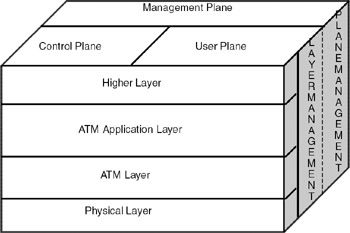29.4 ATM PROTOCOL ARCHITECTURE
|
| < Day Day Up > |
|
29.4 ATM PROTOCOL ARCHITECTURE
The ATM protocol architecture is shown in Figure 29.4.

Figure 29.4: ATM protocol architecture (ITU-T standard).
Physical layer: This layer specifies the transmission data rates and encoding scheme. Data rates of 155.52 and 622.08Mbps are supported. Frame generation and reassembly are done in this layer.
The ATM protocol layers are physical layer, ATM layer and ATM adaptation layer. In addition, user plane, control plane, and management plane are defined to take care of different control and management functions.
ATM layer: Transmission of data in fixed cells using logical connections. The functions of this layer include cell header generation/extraction, flow control, and cell multiplexing and demultiplexing.
ATM adaptation layer: This layer is used to support information transfer protocols that are not based on ATM (such as PCM over ATM). In such cases, segmentation/reassembly of the data is required, which is the function of this layer.
User plane: This plane provides for user information transfer, along with associated controls (such as flow control and error control).
Control plane: This plane performs call control and connection control functions.
Management plane: Functions of this plane include plane management and layer management. Plane management functions are related to the system as a whole and between planes. The layer management module performs management functions related to the resources in the network.
|
| < Day Day Up > |
|
EAN: 2147483647
Pages: 313